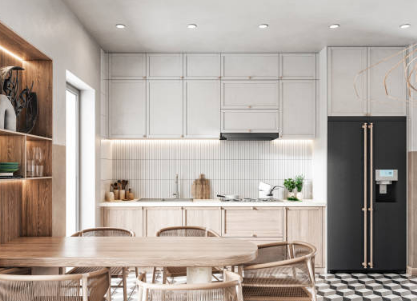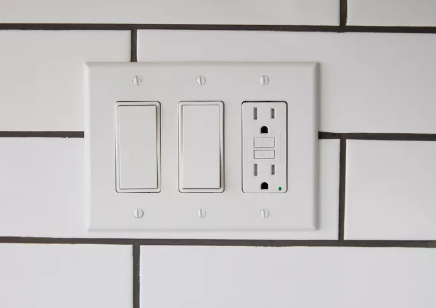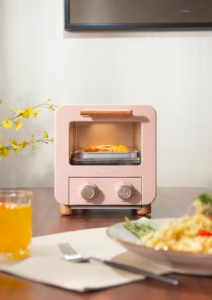Meeting residential electrical code requirements is not intended to satisfy inspectors or to receive a “seal of approval” on the permit. Electrical codes are a flexible set of practices that respond to changing homes. Learning basic kitchen electrical codes can not only create a safer space, but also a more functioning kitchen.
GFCI Protected Circuits for Small Appliances
Requirements: Provide at least two 20 amp, 120 volt circuits to power GFCI (Ground Fault Circuit Breaker) electrical outlets on countertops and dining areas.

Why: In the kitchen, a 20-amp outlet (as opposed to 15 amps) is required to meet higher power requirements due to the use of appliances such as toasters, blenders, coffee makers, and blenders. Two circuits are required to extend the coverage area. In this way, the total load is not served by the same circuit exactly.
Comment: Providing frequent plug points has long been a mainstay of the NEC so that homeowners don’t try to pull the power cord too far. Newer countertop appliance cords are now typically only 2 feet long, and electrical outlets in the kitchen must not be more than 4 feet apart. Therefore, the height of the kitchen air outlet from the counter surface should also not exceed 20 inches.
Basic Lighting Circuits
Requirements: Provide at least one 15 amp, 120 volt circuit to power ceiling fixtures, recessed lights, and any under-cabinet lights. This cannot be seen on GFCI circuits.
The reason: The current intensity required by the luminaire is smaller. However, if you need more lighting, you will have to increase the amperage and other incidental factors such as wire gauges, etc., to meet those needs.
Comment: Electrical codes require at least one lighting circuit to ensure that the kitchen has at least some sort of permanent lighting. The lighting circuit cannot be located on the GFCI in case it is accidentally shut down by other services.
The Distance of the Gfci from the Top of the Countertop
Requirements: The distance between countertop outlets must not exceed 48 inches.
Why: Homeowners should not try to plug in small appliances by stretching the cord more than 24 inches (i.e., half of the 48 inches needed). It is considered good practice to provide GFCI more frequently than once every 48 inches.
Tamper-Proof (Tr) Receptacles
Requirements: All 15 amp and 20 amp outlets, GFCI or not, must be tamper-proof in the following kitchen-related locations: small appliance circuits, countertop space (including kitchen island countertop outlets), wall and hallway spaces.
Cause: In response to the danger of electric shock from children inserting conductive items (paper clips, hairpins, etc.) into the socket, the NEC began requiring the installation of an outlet with a sturdy baffle inside.
Comment: This shutter can only be opened when both power prongs are pushed into the socket with a lot of force at the same time. These sockets are identified by the letter “TR” on the yoke on the front of the socket.

The Countertop Section Is 12 Inches Wide or More
Requirements: Countertop sections that are 12 inches wide or larger are considered walls and must have an outlet (GFCI).
Why: This requirement ensures that any device used will have its own power source, even within a small area.
Dishwasher Circuit
Requirements: Provide a 15 amp, 120 volt dedicated circuit that uses 14/2 cable routing. The NEC Code 2017 cycle now requires dishwashers to be installed on GFCI circuits.
Reason: “Special” is an operating word in the dishwasher electrical code requirements regarding circuits. This means that the dishwasher has its own circuit separate from the fridge and other appliances, so it can’t accidentally trip (at the circuit level), turning off the power to other areas of the kitchen.
Note: 14/2 is the standard cable for 15 amp circuits. Higher amperage circuits are allowed if they are within the operating capacity of the device. If so, you’ll need to replace the cables and outlets.
Garbage Disposal Circuits
Requirements: A 15 amp, 120 volt dedicated circuit with a 14/2 cable connection.
Reason: The garbage disposer doesn’t run as long as a stovetop or microwave. The initial surge is very high, and it is easy to trip the circuit breaker, shutting down other appliances in the kitchen.
Microwave Circuits
Requirements: A 20-amp,120-volt dedicated circuit with a 12/2 cable connection for microwave ovens. If the 2023 changes apply in your region, you may need GFCI protections.
Why: A 20-amp circuit is required to handle the higher power requirements of microwaves. A 12-gauge cable is standard on any 20-amp circuit.

Electric Stove Circuit
Requirements: Provide a 50 amp,120/240 volt dedicated circuit and connect with an appropriately sized cable. This circuit should not be GFCI.
Why: Electric stoves consume more electricity in the kitchen than almost anything else. All parts of this circuit are oversized and isolated: large cables, high-current circuit breakers, and dedicated circuits (so as not to trigger other appliances or lights).
About Kitchen Electrical Codes
The National Fire Protection Association (NFPA) is the organization that creates and updates the National Electrical Code (NEC), which is then adopted in whole or in part by your city.
The basics of electrical codes may seem pointless, but electricians, contractors, and other industry professionals have developed electrical codes through detailed discussions and multiple revisions. Nothing will change without much thought.
For homeowners, the electrical code is less restrictive, but enlightening and constructive. For example, most small appliances, such as blenders, have short wires. The specification requirements for kitchen GFCI outlets state that the distance between the outlets must not exceed 4 feet.
The NFPA updates the code every three years to meet the growing demands of the modern kitchen. If you’re retrofitting an existing old kitchen, most jurisdictions require you to bring the new kitchen into line with current code requirements.
